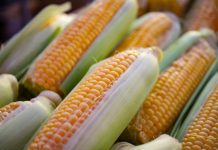Salmon is generally thought to be a heart-healthy food because of the high Omega-3 oils found in the fish. But it can be confusing to buy because of all the press on wild versus farmed-raised salmon or Atlantic versus Pacific salmon. So, let’s take a look at how to choose, store and judge the freshness of salmon.
Table of Contents
What’s the Difference Between Atlantic Salmon and Pacific Salmon?
There is a difference and depending upon which coast of the United States you live on, you’re generally eating salmon caught in your region. Stores on the East Coast usually sell farmed-raised salmon and very little Pacific salmon; on the West Coast the reverse is true.
There are many species of Pacific salmon but only one of Atlantic, which is usually sold gutted and weighs between eight and twelve pounds, however, it’s not all edible as 40 percent of the fish is bones and head. However, both Pacific and Atlantic salmon are members of the same family, which also includes trout and Atlantic char.
Pacific wild salmon may also be sold by the name of the river from the state in which they were caught. You may get the opportunity to buy Columbia River salmon from Washington or Oregon, or Copper River salmon from Alaska.
If the wild salmon being sold doesn’t label it’s origin, ask the fish monger. While there are seven species of Pacific salmon available for purchase, sockeye salmon is the most popular on the West Coast because of its high oil content and convenient size; it’s sold mostly between two and eight pounds.
Which is Better Wild Salmon or Farmed-raised Salmon?
The answer is subjective; it depends upon your taste buds. However, Atlantic wild salmon usually isn’t sold since it’s mostly caught by sports fishermen and not commercial fishermen. Farmed raised salmon is consistently fresh and flavorful because it’s shipped as soon as it’s killed and gutted.
Pacific wild salmon, which is readily available in West coast fish stores, is leaner than Atlantic salmon although its taste varies depending upon where it was caught. Pacific wild salmon varies in taste depending upon where it was caught and this adds to its interesting flavors.
Are There Contaminants in Farmed-raised Salmon?
It’s not the fish that are at issue here, it’s the farming techniques that often have a negative impact on the salmon. Studies have shown that open pens are the cause of many environmental issues when raising farmed salmon because they release a number of contaminants into the water and can damage the surrounding eco-system.
Salmon farmers are now opting for closed pens which utilizes its own water treatment system and eliminates the contaminant problem. If you’re concerned about the contaminant issue, opt for wild salmon that is available for more than half the year; however, you’ll pay more. During the off season, fresh wild salmon “frozen at sea” is available. Talk to your fish monger about your concerns and choices.
How Should Salmon be Stored?
It’s best to eat fresh salmon steaks and fillets the day you buy them and definitely within two days if you’re not going to freeze it. Salmon may be frozen for up three months if it’s wrapped tightly in first plastic wrap and then aluminum foil. Salmon should never be in direct contact with ice. Whole salmon is almost impossible to store unless you have a giant freezer. If you find yourself in possession of a whole salmon have it cut into fillets or steaks.
What are the Cuts of Salmon?
No matter which cut you choose, the cut can determine the portion size so plan on six ounces per serving.
Whole Salmon: This cut of fish includes the entire fish from head to tail although the organs will have been removed. It’s a great cut of fish when you’re serving a large crowd or want to stuff it for an impressive presentation.
Salmon Fillet: Separated from its head, ribs and backbone, a fillet produces two long portions of boneless meat, which is then cut into serving sizes. It’s most often smoked and used as lox with bagels, cream cheese and accompaniments. Fillets are sold in a variety of weights and are ideal for steaming, poaching and pan frying.
Salmon Steaks: Having no head or tail, this cut of salmon is cut through the backbone and produces steaks that are one inch thick, which makes them perfect for grilling.
How to Tell if Salmon is Fresh?
It’s easier to judge the freshness of a whole salmon than it is for a fillet or steak. But not to worry because the system for getting salmon from the farm to the table is so efficient, it usually arrives in the freshest condition. A whole salmon should sparkle. The skin should be shiny and silvery with no dark patches; this happens when the scales rub off from mishandling. The eyes should be crystal clear and protrude gently from the head. Take a look at the gills by asking the fish monger to pick up the flap at the base of the head. The gills should be a deep pink and have a clean odor. If you smell anything “fishy”, don’t buy it.
Hit the fish market, take the plunge and enjoy this heart-healthy fish. Whether you choose wild or farmed raised salmon, you’ll benefit from the nutrients salmon offers.



